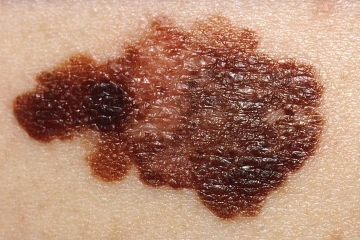Revolutionizing skin cancer care through data
Researchers are filling a knowledge gap by building a powerful tool to accelerate the development of diagnostic and prognostic technologies.

Arizona’s warmer climate, which entices people to spend time outdoors year-round, combines with the state’s elevation and proximity to the equator to increase Arizonans’ risk of skin cancer.
Millions of cases of skin cancer are diagnosed globally each year. More people are diagnosed with skin cancer each year in the U.S. than all other cancers combined, and at least 1 in 5 Americans will develop skin cancer by the age of 70, according to the Skin Cancer Foundation. Yet national cancer registries only track a small proportion of skin cancers, which can be devastating to individuals and families when overlooked.

In the U.S., 97% of diagnosed skin cancers are non-melanoma and not required to be reported to state cancer registries. The Patient Registry, Imaging Database and Tissue Bank, or PRIT, contains information on both melanoma and non-melanoma skin cancers.
“Melanoma can spread through the body and currently leads the mortality rate when compared to other type of skin cancers. Therefore, the vast majority of databases prioritize this type of tumor for data and tissue collection,” said Clara Curiel-Lewandrowski, MD, co-director of University of Arizona Skin Cancer Institute in the UArizona Cancer Center. “But that also means we don’t have a great way to properly assess other skin cancer cases, which are exponentially increasing worldwide. Skin cancers represent a significant morbidity to patients and a high economic burden to society by the sheer number of tumors diagnosed each year, including more than 5 million in the U.S. alone.”
Basal cell and squamous cell carcinomas, which are both non-melanoma skin cancers, account for 97% of skin cancers diagnosed in the U.S. and are not required to be reported to state cancer registries. To gain a more complete picture of skin cancer and address gaps in diagnostic and prognostic tools, University of Arizona Health Sciences researchers created a database for melanoma and non-melanoma skin cancer that links patient data, images and tissue.
Patients are very receptive; they appreciate that an academic medical environment is seeking to identify solutions to their medical challenges.
Clara Curiel-Lewandrowski, MD
The Patient Registry, Imaging Database and Tissue Bank, or PRIT, represents a unique resource researchers can use to develop novel tools to help doctors diagnose and predict likely outcomes for skin cancer. The latter may eventually include the development of artificial intelligence software to recognize, diagnose and classify skin cancers according to risk of metastatic disease. In addition, researchers can use the data to aid in biomarker discovery and the identification of new targets for well-tolerated preventive and therapeutic strategies.
What sets PRIT apart from other databases around the world are: the ease of implementation and acquisition of data in busy clinical environments; and the potential to combine imaging and tissue biomarkers to enhance the accuracy of current technologies that rely on imaging or tissue analysis alone.
“Coupling these technologies is the way of the future and we need to build the infrastructure to empower scientists to identify solutions that will enhance the early detection of skin cancer in a non-invasive manner while minimizing unnecessary skin biopsies”, said Dr. Curiel-Lewandrowski, who is also a professor and chief of the Division of Dermatology at the College of Medicine — Tucson. “To achieve this ambitious and challenging goal, we partnered with data scientists at UArizona Health Sciences to build a system architecture for this project; they were instrumental in making our vision a reality.”
Putting the pieces together
Biology is complex. Storing and organizing biological data can be a daunting task and often requires separating different types of information into specialized computer systems. One of the challenges of biomedical science is trying to connect these independent systems in a way that can be useful to clinicians and researchers.

Nirav Merchant, director of the Data Science Institute and interim director of the Biomedical Informatics and Biostatistics Center, is an expert at improving research productivity and collaboration with the development of computational platforms.
“PRIT is greater than the sum of its parts, but you can think of it as being built on three pillars,” said Nirav Merchant, director of the university’s Data Science Institute and interim director of the Center for Biomedical Informatics and Biostatistics at UArizona Health Sciences. “It brings together three separate computer programs to make them more manageable and clinically useful. This allows Dr. Curiel-Lewandrowski’s team and potentially other researchers, centers and universities to field a larger body of data sets and make decisions in a consistent and organized manner.”
PRIT combines the programs REDCap, OpenSpecimen and OMERO. REDCap is a secure web application for building and managing online surveys and databases. Open Specimen is a bio-banking platform to collect, store, process, annotate and distribute bio-specimens in a cohesive bio-banking database. OMERO is a software for managing, visualizing and analyzing microscopy images and associated metadata. By combining the three platforms, researchers now have access to anonymized patient data that includes information such as age, gender and location, a bank of biospecimens, and a library of skin cancer images. All of this is now all in one place and linked together.

Clara Curiel-Lewandrowski, MD, has focused much of her research in photobiology, early skin cancer detection and primary prevention. She aims to address clinical gaps in skin cancer primary prevention and early detection fields through innovative study designs and effective execution.
“So now when you're looking at an image, you can go pull up more information about the patient from REDCap and identify skin tissue associated with that specific lesion. Similarly, if you were looking at something in REDCap, and you knew that there were images for that patient, you can go see them and retrieve a tissue sample if available. So even though they are three independent systems, they are nicely connected and integrated in PRIT,” Merchant said.
Dr. Curiel-Lewandrowski’s team has enrolled more than 180 subjects and collected 49 tissue samples and 261 images since launching PRIT in October 2022. They are now scaling the project across two institutional sites, with the eventual goal of incorporating community medical providers to expand data acquisition.
“We have coordinators in the clinic who invite patients needing a skin biopsy to participate in the project. We are embedded into the flow and operation of the clinic,” she said. “Patients are very receptive; they appreciate that an academic medical environment is seeking to identify solutions to their medical challenges. In addition, their engagement in PRIT is straightforward and requires minimal time to participate.”
Setting the stage for machine learning
PRIT’s unique storage and management of large amounts of complex data make for a powerful tool.
“PRIT is a great example of how investing in technology development can have unforeseen benefits,” Merchant said. “Next steps would be to bring in more modern machine learning and AI techniques. All these images are now labeled and connected to libraries of other data. When you bring in an unknown image, AI could pull up the closest matching image and provide a repository of other information about it. It is hard for a human to look at an image of skin cancer and describe it in nuanced detail that would separate it from all the other images of skin cancer. But computers are very good at sorting and matching images.”
To Dr. Curiel-Lewandrowski, PRIT is an exciting advancement that can maximize research opportunities that may lead to improved patient outcomes.
“The beauty of PRIT is how versatile it is,” she said. “It can be plugged into so many different applications including the development of combined imaging and biomarker AI algorithms that can revolutionize non-invasive diagnostic and prognostic tools. We’re enabling the solutions to close the gap in skin cancer care.”
Our Experts
Clara N. Curiel-Lewandrowski, MD
Professor, College of Medicine – Tucson
Chief, Division of Dermatology, College of Medicine – Tucson
Co-Director, UArizona Skin Cancer Institute
Director, Multidisciplinary Cutaneous Oncology Program, UArizona Skin Cancer Institute
Director, Pigmented Lesion Clinic, UArizona Skin Cancer Institute
Alan and Janice Levin Family Endowed Chair for Excellence in Cancer Research
Member, BIO5 Institute and UArizona Cancer Center
Nirav Merchant, MS
Director, Cyber Innovation
Director, Data Science Institute
Interim Director, Center for Biomedical Informatics and Biostatistics
Contact
Brian Brennan
UArizona Health Sciences
520-621-3510
brianbrennan@arizona.edu

